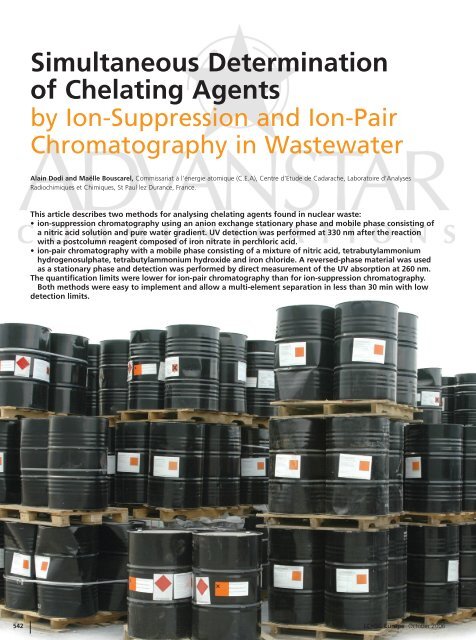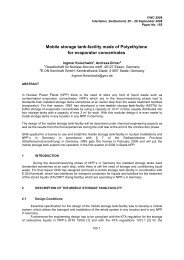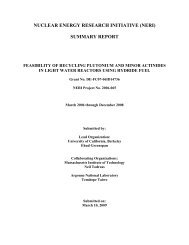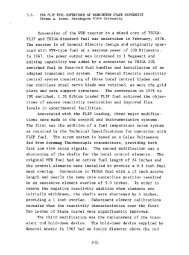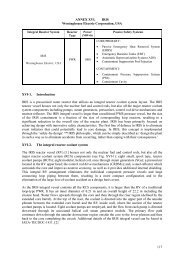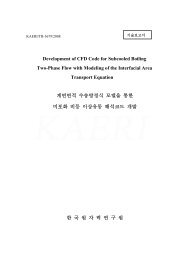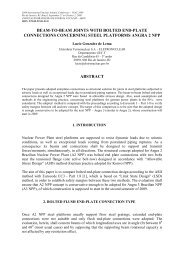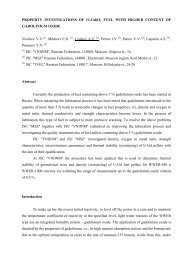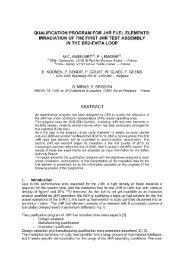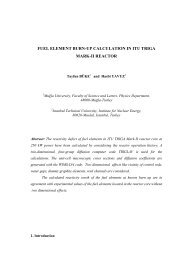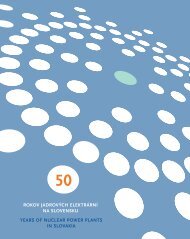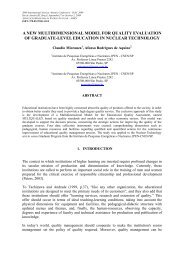Simultaneous Determination of Chelating Agents
Simultaneous Determination of Chelating Agents
Simultaneous Determination of Chelating Agents
You also want an ePaper? Increase the reach of your titles
YUMPU automatically turns print PDFs into web optimized ePapers that Google loves.
<strong>Simultaneous</strong> <strong>Determination</strong><br />
<strong>of</strong> <strong>Chelating</strong> <strong>Agents</strong><br />
by Ion-Suppression and Ion-Pair<br />
Chromatography in Wastewater<br />
Alain Dodi and Maëlle Bouscarel, Commissariat à l’énergie atomique (C.E.A), Centre d’Etude de Cadarache, Laboratoire d’Analyses<br />
Radiochimiques et Chimiques, St Paul lez Durance, France.<br />
This article describes two methods for analysing chelating agents found in nuclear waste:<br />
• ion-suppression chromatography using an anion exchange stationary phase and mobile phase consisting <strong>of</strong><br />
a nitric acid solution and pure water gradient. UV detection was performed at 330 nm after the reaction<br />
with a postcolumn reagent composed <strong>of</strong> iron nitrate in perchloric acid.<br />
• ion-pair chromatography with a mobile phase consisting <strong>of</strong> a mixture <strong>of</strong> nitric acid, tetrabutylammonium<br />
hydrogenosulphate, tetrabutylammonium hydroxide and iron chloride. A reversed-phase material was used<br />
as a stationary phase and detection was performed by direct measurement <strong>of</strong> the UV absorption at 260 nm.<br />
The quantification limits were lower for ion-pair chromatography than for ion-suppression chromatography.<br />
Both methods were easy to implement and allow a multi-element separation in less than 30 min with low<br />
detection limits.<br />
542<br />
LC•GC Europe October 2006
Dodi and Bouscarel<br />
Nuclear waste regulations are becoming increasingly stringent<br />
and aminopolycarboxylic acids must be analysed in nuclear<br />
waste packages. Indeed, these species form water-soluble<br />
complexes with most heavy metals, which may result in the<br />
contamination <strong>of</strong> soils by radioactive elements. For example,<br />
studies at Oak Ridge National Laboratory (Tennessee, USA)<br />
have demonstrated that ethylenediaminetetracetic acid (EDTA)<br />
caused the low-level migration <strong>of</strong> 60 Co from intermediate-level<br />
liquid waste disposal pits and trenches. 1<br />
Thus, chelating agents such as nitrilotriacetic acid (NTA),<br />
ethylenediaminetetracetic acid, cyclohexanediaminetetracetic<br />
acid (CDTA) and diethylenetriaminepentacetic acid (DTPA)<br />
are considered by ANDRA (the French national agency for<br />
radioactive waste management) as compounds to be<br />
investigated because they may enhance the release <strong>of</strong><br />
radioactive isotopes in the environment. 2<br />
Ringbom explained that the chelating agents exhibit strong<br />
complexing power because <strong>of</strong> their carboxylic functions and<br />
their nitrogen and oxygen atoms. 3 The complexation constants<br />
<strong>of</strong> iron (III) with chelates shows that these complexes are<br />
particularly stable. 4<br />
Buchberger and Mülleder demonstrated that the stability <strong>of</strong><br />
the complexes depends on the pH. 5 When the pH increases,<br />
the chelating agents are more and more deprotonated and<br />
exhibit their complexing power (but obviously, at increasing<br />
pH metal ions may precipitate, which decreases the apparent<br />
stability).<br />
The chelating agents, such as EDTA, are largely used for the<br />
detection <strong>of</strong> metals by UV detection. For this reason metal<br />
(iron) complexes are generally used to perform the detection <strong>of</strong><br />
these aminopolycarboxylic acids. Different analytical techniques<br />
have been used to perform the determination <strong>of</strong> chelating<br />
agents.<br />
Owens et al. studied EDTA and NTA with different metallic<br />
ions by capillary electrophoresis (CE), the determination limit<br />
for the iron–EDTA complex was 4 mg/L. 6 Padarauskas et al.<br />
also separated EDTA, CDTA and DTPA by CE as<br />
complexes with metallic ions. 7 The determination<br />
limits for the complex iron–DTPA was<br />
0.9 mg/L. Laamanen et al., determined DTPA,<br />
EDTA and NTA by CE after complexation<br />
with Cu ions. 8<br />
Collins et al. exploited ion chromatography/mass<br />
spectrometry to quantify metal–EDTA complexes in soil<br />
solution; with this method it was possible to identify and<br />
quantify the metal–EDTA complexes in environmental<br />
samples. 9 Nevertheless, iron (III)–EDTA, Ca–EDTA,<br />
Mg–EDTA and EDTA itself were not detected. Miller et al.<br />
analysed EDTA in dried bloodstains by ion chromatography and<br />
electrospray liquid chromatography/mass spectrometry/mass<br />
spectrometry (LC–MS–MS). 10 Nevertheless, the determination<br />
limit was only 5 mg/L. Dodi et al. used electrospray LC–MS to<br />
investigate EDTA traces in nuclear wastes. Quantification limits<br />
<strong>of</strong> 2 µg/L (for 20 µL injected) were achieved. 11<br />
A German standard, dealing with the analysis <strong>of</strong> water,<br />
wastewater and sludge, describes the determination <strong>of</strong> NTA,<br />
EDTA and DTPA through LC; determination limits were<br />
70 µg/L, 40 µg/L and 120 µg/L, respectively. 12 A similar<br />
work was published as an application note from Macherey<br />
Nagel to investigate EDTA, NTA, DTPA. 13<br />
A French standard was published for the determination <strong>of</strong><br />
chelating agents (EDTA, HEDTA and DTPA) in fertilizers<br />
using ion chromatography. 14 Moreover, an application note<br />
from Dionex proposed the quantification <strong>of</strong> EDTA, NTA and<br />
phosphates by ion-suppression chromatography. 15<br />
The determination <strong>of</strong> these chelating agents by gas<br />
chromatography has also been reported 1,16,17 but the main<br />
drawback <strong>of</strong> this technique is the need to perform a<br />
derivatization step prior to injection. All samples must be<br />
treated with an esterification reagent prior to analysis but the<br />
yield <strong>of</strong> the reaction may depend on the sample matrix.<br />
Nowack and co-authors have reported works in ion<br />
chromatography coupled with ICP/MS to separate<br />
organometallic complexes with a mobile phase composed <strong>of</strong><br />
NH 4 NO 3 . 18 The quantification limit for EDTA is between 0.5<br />
and 1.0 µM.<br />
The aim <strong>of</strong> this article is to propose and to compare two ion<br />
chromatographic methods (ion-suppression and ion-pair<br />
chromatography) for the simultaneous determination <strong>of</strong> four<br />
aminopolycarboxylic compounds: NTA, EDTA, CDTA, DTPA<br />
(Figure 1) with low detection limits.<br />
Figure 1: Structural formulae <strong>of</strong> the different chelating agents.<br />
EDTA<br />
C 10 H 16 N 2 O 8<br />
NTA<br />
C 6 H 9 NO 6<br />
O OH<br />
O<br />
HO<br />
O<br />
OH<br />
N<br />
N<br />
HO<br />
O<br />
OH<br />
O<br />
CDTA<br />
C 14 H 22 N 2 O 8 ,H 2 O<br />
O<br />
OH<br />
O<br />
N<br />
HO<br />
O<br />
O<br />
OH<br />
O<br />
HO<br />
DTPA<br />
C 14 H 23 N 3 O 10<br />
O<br />
N<br />
N<br />
O<br />
OH<br />
OH<br />
O<br />
N<br />
HO<br />
N<br />
HO<br />
O<br />
OH<br />
OH<br />
N<br />
O<br />
O<br />
OH<br />
www.lcgceurope.com<br />
543
Dodi and Bouscarel<br />
<strong>Chelating</strong> agents such as NTA, CDTA and<br />
DTPA are considered by ANDRA (the French<br />
national agency for radioactive waste<br />
management) as compounds to be<br />
investigated because they may enhance the<br />
release <strong>of</strong> radioactive isotopes in the<br />
environment.<br />
Experimental<br />
Materials: For all eluent and standard preparations, deionized<br />
(DI) water was provided by a point-<strong>of</strong>-use water-purification<br />
system from Millipore (St Quentin en Yvelines, France). Milli-Q<br />
gradient A10 was linked to an Elix and Rios system. The eluents<br />
and DI water reservoirs were purged with helium before<br />
performing the separation. The standard solutions were<br />
prepared from EDTA (Titriplex III), NTA (Titriplex I), CDTA<br />
(Titriplex IV) and DTPA (Titriplex V) purchased from Merck<br />
(Darmstadt, Germany).<br />
Ion-suppression chromatography: A nitric acid solution<br />
(100 mM) was prepared from a 69% solution purchased from<br />
Merck. This solution was poured into a 1 L flask and a second<br />
flask was filled with DI water. The postcolumn reagent was<br />
prepared in a 1 L flask with 1 g <strong>of</strong> iron (III) nitrate<br />
nonahydrate purchased from Prolabo (Paris, France) and<br />
20 mL <strong>of</strong> 70–72% perchloric acid solution from Merck.<br />
Ion-pair chromatography: Preparation <strong>of</strong> the eluent required a<br />
diluted nitric acid solution (prepared from a commercial 69%<br />
solution purchased from Merck), tetra-n-butylammonium<br />
hydroxide (prepared from a commercial 40% solution) from<br />
VWR (Fontenay sous bois, France), tetra-n-butylammonium<br />
hydrogenosulphate from Merck and anhydrous iron (III)<br />
chloride from VWR.<br />
Apparatus and Columns<br />
On both systems, a Dionex (Sunnyvale, California, USA)<br />
DX 500 ion chromatograph equipped with a manual degassing<br />
system, an automatic sampler, a quaternary gradient pump and<br />
an AD 20 absorbance detector was used.<br />
The sample loop size was 500 µL on both methods. Samples<br />
were introduced into the instrument via an AS40 automated<br />
sampler, using 5 mL PolyVials with pain caps. All instrument<br />
modules were purchased from Dionex. Instrument control and<br />
data collection were performed with a PC and Peaknet s<strong>of</strong>tware<br />
(Dionex).<br />
For ion-suppression chromatography an AS7 column (4 <br />
250 mm) equipped with an AG7 guard column (4 50 mm<br />
from Dionex) was implemented. The mean particle size <strong>of</strong> the<br />
Figure 2: Chromatogram <strong>of</strong> the aminopolycarboxylic acids<br />
(EDTA 1 mg/L, CDTA and DTPA 0.5 mg/L, NTA 2 mg/L) in ion<br />
suppression chromatography.<br />
AU<br />
8 10 3<br />
6 10 3<br />
4 10 3<br />
2 10 3<br />
0<br />
2 10 3<br />
0<br />
1–CDTA<br />
2–EDTA<br />
3–DTPA<br />
4–NTA<br />
2 4 6 8 10 12 14 16<br />
Time (min)<br />
resin was 10 µm (data given by the manufacturer). A GP 40<br />
gradient pump mixed the eluent constituents (water and<br />
100 mM HNO 3 ) for the gradient program used. The flow-rate<br />
was adjusted to 1.0 mL/min, and the UV/visible module was<br />
set at a wavelength <strong>of</strong> 330 nm. With this system, a postcolumn<br />
reagent was mixed with the mobile phase through a mixture<br />
chamber, just before detection.<br />
In ion-pair chromatography the stationary phase tested was<br />
an RP Nucleodur C 18 Pyramid (4 250 mm) from Macherey<br />
Nagel (5 µm mean particle diameter). The GP 40 gradient<br />
pump was also used but no gradient program was established.<br />
The flow-rate was adjusted during the separation.<br />
The flow-rate was 0.8 mL/min for 15 min, after which it was<br />
set at 1.10 mL/min to reduce the elution time <strong>of</strong> the last peak<br />
(CDTA). Detection was performed with an absorbance<br />
detector (AD 20) at 260 nm.<br />
Standard Preparation<br />
Eppendorf (Hamburg, Germany) research pro pipettes were<br />
used to prepare standard and sample solutions. A stock solution<br />
Table 1: pKa and [A - ]/[AH] ratio (calculated at pH 2.6) for the<br />
two first acidities <strong>of</strong> the aminopolycarboxylates.<br />
pKa 1 [A - ]/[AH] pKa 2 [A - ]/[AH]<br />
NTA 1.90 5 2.50 1.26<br />
DTPA 1.94 4.57 2.87 0.54<br />
EDTA 2.07 3.4 2.75 0.7<br />
CDTA 2.51 1.23 3.60 0.1<br />
Table 2: Calibration curves parameters, detection limits and quantification limits calculated for the ion suppression<br />
chromatography method.<br />
Least-squares equations Correlation coefficients DL (mole/L) QL (mole/L)<br />
CDTA y 187.91x 5883.87 0.9954 0.067 0.225<br />
EDTA y 154.09x 2335.7 0.9979 0.053 0.178<br />
DTPA y 84.33x 7920.52 0.9804 0.124 0.413<br />
NTA y 66.78x 1341.2 0.9945 0.134 0.446<br />
544<br />
LC•GC Europe October 2006
Dodi and Bouscarel<br />
Table 3: Calibration curves parameters, detection limits and quantification limits calculated for the ion pair chromatography<br />
method.<br />
Least-squares equations Correlation coefficients DL (mole/L) QL (mole/L)<br />
NTA y 1210.34x 10324.27 0.9998 0.011 0.037<br />
EDTA y 1001.69x 24903.57 0.9989 0.015 0.051<br />
DTPA y 982.83x 4954.71 0.9989 0.011 0.038<br />
CDTA y 922.54x 5190.41 0.9936 0.031 0.104<br />
(500 mg/L) <strong>of</strong> NTA, EDTA, DTPA and (100 mg/L) CDTA<br />
was prepared by dissolving the commercially available product<br />
in deionized water. Diluted solutions for analysis were freshly<br />
prepared everyday <strong>of</strong> analysis.<br />
On Guard M Resin<br />
This ion exchanger (purchased from Dionex) permits the<br />
retention <strong>of</strong> cationic metals and was used to perform the tests<br />
dealing with the influence <strong>of</strong> metals.<br />
Calculations<br />
Statistical calculations were performed using the formula given<br />
below (from reference 19):<br />
Figure 3: Chromatogram <strong>of</strong> the aminopolycarboxylic acids<br />
(1 mg/L each) in ion pair chromatography.<br />
AU<br />
1.75 10 2<br />
1.50 10 2<br />
1.25 10 2<br />
1.00 10 2<br />
7.00 10 3<br />
5.00 10 3<br />
2.50 10 3 0<br />
1–NTA<br />
2–EDTA<br />
3–DTPA<br />
0 5 10 15 20 25<br />
Time (min)<br />
4–CDTA<br />
3 S b0<br />
LD [1]<br />
b1<br />
10 S b0<br />
LQ [2]<br />
b1<br />
Figure 4: Variation <strong>of</strong> the measured concentration when a<br />
metal excess (1000 times more) is added to the complexant.<br />
where S b0 is the standard deviation measured with a low level<br />
standard and b1 is the slope <strong>of</strong> the calibration curve.<br />
Results and Discussion<br />
Ion-suppression chromatography: Usually, chromatography <strong>of</strong><br />
anions is performed with a basic mobile phase. In the instance<br />
<strong>of</strong> aminopolycarboxylic compounds, these anions would be too<br />
strongly retained on the resin with a basic media; for this<br />
reason it was necessary to proceed by ion-suppression<br />
chromatography with an acidic mobile phase.<br />
The eluent was composed <strong>of</strong> a gradient between water and a<br />
100 mM nitric acid solution ([HNO 3 ] 15 mM from<br />
0–7 min, to reach 20 mM at 17 min). The flow-rate was<br />
adjusted to 1 mL/min and the observed pressure was about<br />
7.6 MPa (1100 psi). The chromatogram displayed in Figure 2<br />
shows that the first eluted compound is CDTA followed by<br />
EDTA, then DTPA and NTA.<br />
This order <strong>of</strong> elution may be explained if we consider the<br />
pKa 1 <strong>of</strong> the chelating agents (Table 1). The pH <strong>of</strong> the mobile<br />
phase was 2.6; subsequently, the higher the pKa 1 , the lower the<br />
concentration <strong>of</strong> the deprotonated form (A ) and thus the<br />
species is less retained on the resin. The pKa 1 values (and the<br />
[A ]/[AH] calculated ratio) indicated in Table 1 allow us to<br />
explain the observed elution order.<br />
Linearity was obtained up to 1 mg/L, according to the<br />
XP T 90–210 AFNOR standard. The least-squares equations<br />
and the correlation coefficients for each compound are<br />
reported in Table 2.<br />
Then the limits <strong>of</strong> detection (LD) and quantification (LQ)<br />
were calculated with the formula given earlier, according to<br />
Concentration (µg/L)<br />
700<br />
600<br />
500<br />
400<br />
300<br />
200<br />
100<br />
0<br />
No metal<br />
Excess<br />
Cu<br />
Excess<br />
Co<br />
Excess<br />
Pb<br />
NTA<br />
EDTA<br />
DTPA<br />
CDTA<br />
XP T 90–210 AFNOR standard; the results are shown in<br />
Table 2. The mean noise observed with this method was 65 µAU.<br />
Ion-pair chromatography: The mobile phase was composed <strong>of</strong><br />
0.6 mM HNO 3 , 2.6 mM tetrabutylammonium hydroxide,<br />
7.53 mM tetrabutylammonium hydrogenosulphate and 37 µM<br />
anhydrous iron (III) chloride (from reference 13). The pH <strong>of</strong><br />
this mobile phase was 2.33.<br />
The tetrabutylammonium groups <strong>of</strong> the ion pairing reagents<br />
are maintained close to the C18 alkyl chains by hydrophobic<br />
interaction and the cationic ammonium moiety allows the reverse<br />
phase to have a similar behaviour as a dynamic anion exchanger.<br />
The flow-rate was adjusted to 0.8 mL/min and the observed<br />
pressure was 11 MPa (1600 psi); when the flow-rate was<br />
546<br />
LC•GC Europe October 2006
Dodi and Bouscarel<br />
increased at 1.1 mL/min, the pressure reached values <strong>of</strong><br />
approximately 17.6 MPa (2550 psi).<br />
As we can see in Figure 3, the elution order is different from<br />
the one observed for ion-suppression chromatography. In fact,<br />
the retention time seems to be correlated with the number <strong>of</strong><br />
carboxylic functions present in the compound; the more the<br />
chelating agent has carboxylic functions, the more the ferric<br />
complex is retained on the stationary phase.<br />
We must note that CDTA constitutes an exception because<br />
this molecule exhibits a hydrophobic structure (C 6 cycle)<br />
(Figure 1) and thus, strong hydrophobic interactions occur<br />
between CDTA and the alkyl groups <strong>of</strong> the stationary phase.<br />
Linearity was observed up to 500 µg/L. The least-squares<br />
equations and the correlation coefficients for each compound<br />
are presented in Table 3.<br />
<strong>Chelating</strong> agents must be taken into<br />
account in the management <strong>of</strong> (nuclear)<br />
waste because they can induce watersoluble<br />
complexes with most heavy metals.<br />
copper, cobalt and lead. We prepared aqueous solutions with a<br />
10 3 ratio metal/chelating agent.<br />
In this instance, a complex was formed between the metal<br />
and the chelating agent but a metal excess remained in the<br />
solution. The samples were investigated by ion pair<br />
chromatography and the results are reported in Figure 4. We<br />
may observe that cobalt modified the concentration <strong>of</strong> NTA<br />
and CDTA, copper modified the concentration <strong>of</strong> CDTA and<br />
DTPA and lead did not alter any concentration.<br />
To remove metals present in the sample, we pretreated an<br />
aliquot <strong>of</strong> the sample with a resin adapted for metal retention<br />
(On Guard M resins from Dionex). For that purpose, an aliquot<br />
was previously eluted through the resin cartridge for removing<br />
the metal. The results reported in Figure 5 show that after this<br />
pretreatment, all the metal interferences were removed except<br />
the cobalt CDTA interference which remains significant.<br />
Therefore, in the situation <strong>of</strong> a matrix containing a high<br />
metallic charge, the On guard M resin may be used to limit the<br />
influence <strong>of</strong> metals but it does not completely suppress the<br />
effect <strong>of</strong> all the metals. We can note that the pK c value <strong>of</strong><br />
cobalt with CDTA is particularly high (21.9).<br />
Application to a real sample: A real sample, containing a high<br />
load in salt (NaCl and Na 2 SO 4 at about 10 g/L), in which we<br />
The detection and determination limits are also shown in<br />
Table 3. They were calculated in the same way as for ionsuppression<br />
chromatography. The noise observed with this<br />
method was 37 µAU (half that observed with ion-suppression<br />
chromatography).<br />
Comparison <strong>of</strong> the two methods: Ion-pair chromatography<br />
induced lower detection limits than ion suppression<br />
chromatography (for the same injected volume).<br />
We noted that the background signal was higher (65 µAU)<br />
in ion-suppression than in ion-pair chromatography (37 µAU).<br />
This may be explained by the technique itself.<br />
With ion-suppression chromatography, a postcolumn reagent<br />
was added to the flow issued from the column through a<br />
mixture chamber (thin tube containing micro balls). This<br />
operation constitutes an important source <strong>of</strong> analytical noise<br />
and for this reason, among others, the technique is less<br />
sensitive than ion-pair chromatography, which does not need a<br />
postcolumn reagent; iron (III) being present in the mobile<br />
phase. We might introduce iron (III) in the mobile phase with<br />
the ion-suppression chromatography method, but this could be<br />
detrimental for the anion exchange resin.<br />
As far as the elution time is concerned, we observe that the<br />
ion suppression method allowed a faster separation than ion<br />
pair chromatography in spite <strong>of</strong> a flow-rate modification<br />
performed at 15 min after the start <strong>of</strong> the run (increase <strong>of</strong> the<br />
flow-rate from 0.8–1.1 mL/min) for this last method.<br />
However, we preferred to implement ion-pair chromatography,<br />
which exhibits lower detection limits. (The possibility <strong>of</strong> having<br />
an automatic sampler connected to the chromatograph allowed us<br />
to accept relatively long retention times.)<br />
Influence <strong>of</strong> metals (ion pair chromatography): Usually the<br />
investigated chelating agents are present in media, which may<br />
contain metals and thus, organometallic complexes can be<br />
formed because <strong>of</strong> the presence <strong>of</strong> these metals in the sample.<br />
For that reason, tests were performed with different metals<br />
previously added in a synthetic solution <strong>of</strong> the<br />
aminopolycarboxylic compound. The tested metals were<br />
Figure 5: Figure 4 with a previous elution <strong>of</strong> the sample<br />
(metal + complexant) through an On Guard M resin cartridge<br />
(Dionex).<br />
Concentration (µg/L)<br />
600<br />
500<br />
400<br />
300<br />
200<br />
100<br />
0<br />
Figure 6: Chromatogram <strong>of</strong> a diluted sample containing a<br />
high charge in salt (several g/L in NaCl and Na 2 SO 4 ). The<br />
flow-rate has been reduced (0.6 mL/min instead <strong>of</strong><br />
0.8 mL/min).<br />
AU<br />
No metal<br />
Excess<br />
Cu–On<br />
Guard M<br />
1 10 1<br />
8 10 2<br />
6 10 2<br />
EDTA<br />
4 10 2<br />
2 10 2 0<br />
Excess<br />
Co–On<br />
Guard M<br />
Excess<br />
Pb–On<br />
Guard M<br />
5 10 15 20<br />
Time (min)<br />
NTA<br />
EDTA<br />
DTPA<br />
CDTA<br />
548<br />
LC•GC Europe October 2006
Dodi and Bouscarel<br />
had to measure EDTA, was investigated by ion-pair<br />
chromatography. The result is presented in Figure 6. Standard<br />
addition allowed us to prove that the main peak was EDTA.<br />
The measurement was then performed by ion-pair<br />
chromatography (concentration found 29.4 mg/L) and by a<br />
well-known method, LC/ESI/MS (value found 30.7<br />
mg/L). 11 The high saline load did not perturb the<br />
measurement and so ion-pair chromatography may be<br />
implemented for such samples.<br />
Conclusion<br />
The environment is an important preoccupation and for this<br />
reason chelating agents must be taken into account in the<br />
management <strong>of</strong> (nuclear) waste because they can induce watersoluble<br />
complexes with most heavy metals. The two methods<br />
we developed are easy to implement and permit the<br />
simultaneous analysis <strong>of</strong> NTA, EDTA, DTPA and CDTA in less<br />
than 30 min.<br />
Ion-suppression chromatography allows the separation <strong>of</strong><br />
NTA, EDTA, CDTA and DTPA in less than 20 min and the<br />
quantification limits are in the range <strong>of</strong> 0.18–0.45 µmole/L<br />
(with a 500 µL injection loop).<br />
The ion-pair chromatography method is most interesting<br />
because it is more sensitive. This is probably because the<br />
technique does not require the addition <strong>of</strong> a postcolumn<br />
reagent (this reagent being present in the mobile phase) via a<br />
mixture chamber which is one <strong>of</strong> the main causes <strong>of</strong> analytical<br />
noise. With this latter technique, the detection limits are in the<br />
range <strong>of</strong> 0.04–0.1 µmole/L (with a 500 µL injection loop) but<br />
the last peak (CDTA) is eluted at 28 min. This relatively long<br />
separation time does not constitute a problem if an automatic<br />
sampler is connected to the chromatograph.<br />
We have shown that transition metals could influence the<br />
signal if they are present at high concentrations in the sample.<br />
Therefore, the previous elution <strong>of</strong> an aliquot <strong>of</strong> the sample<br />
through an On Guard M resin cartridge enables this effect to<br />
be reduced.<br />
Acknowledgements<br />
We acknowledge Pr<strong>of</strong>essor A.M. Siouffi for fruitful discussion.<br />
References<br />
1. K.E. Grant et al., J. Radioanal. and Nuclear Chem., 211(2), 383–402<br />
(1996).<br />
2. ANDRA (French national agency for the management <strong>of</strong> nuclear wastes)<br />
— Spécification. Document : ACO SP ASRE 99.001/2 (Mai 1999).<br />
3. A. Ringbom, Les complexes en chimie analytique, Ed Dunod, (Paris<br />
1967).<br />
4. L.G. Sillén, Stability constants <strong>of</strong> metal-ion complexes, The Chemical<br />
Society, Burlington House, London, UK.<br />
5. W. Buchberger and S. Mülleder, Mikrochimica Acta., 119(1–2), 103–111<br />
(1995).<br />
6. G. Owens et al., Environmental Science and Technology, 34, 885–891<br />
(2000).<br />
7. A. Padarauskas and G. Schwedt, J. Chromatogr. A, 773, 351–360(1997).<br />
8. P.-L. Laamanen, Anal. Bioanal. Chem., 381(6), 1264–1271 (2005).<br />
9. R.N. Collins et al., Environmental Science and Technology, 35(12),<br />
2589–2593 (2001).<br />
10. M.L. Miller et al., J. Anal. Toxicol., 21(7), 521–528 (1997).<br />
11. A. Dodi and V. Monnier, J. Chromatogr. A, 1032, 87–92 (2004).<br />
12. DIN 38413-8: 200-09 ICS 13.060.50. German standard methods for the<br />
examination <strong>of</strong> water, wastewater and sludge individual constituents<br />
(group P). Part 8: <strong>Determination</strong> <strong>of</strong> nitriloacetic acid (NTA),<br />
ethylenediamine tetraacetic acid (EDTA) and diethylenetriamine<br />
pentaacetic acid (DTPA) by liquid chromatography (P8).<br />
13. Macherey Nagel, Application note N° 119780: Complexing agents.<br />
14. AFNOR, NF EN 13368–1 <strong>Determination</strong> des agents chélatants dans les<br />
engrais par chromatographie ionique Partie 1: EDTA, HEDTA et DTPA<br />
Ed AFNOR (2001).<br />
15. Dionex, Document N° 031299-05, 7 November 2002.<br />
16. AFNOR, NF ISO 16588 Qualité de l’eau — Dosage de six agents<br />
complexants — Méthode par chromatographie gazeuse, Ed AFNOR<br />
(2004).<br />
17. M. Sillanpää, J. Sorvari and M.L. Sihvonen, Chromatographia, 42,<br />
578–582 (1996).<br />
18. B. Nowack and J.M. Von Briesen, Biogeochemistry <strong>of</strong> chelating agents.<br />
American Chemical Society, Washington, DC: 1–18.<br />
19. Standard AFNOR XP T 90-210. Protocole d’évaluation d’une méthode<br />
alternative d’analyse physico-chimique quantitative par rapport à une<br />
méthode de référence. Ed AFNOR (1999).<br />
Alain Dodi graduated from the High School <strong>of</strong> Chemistry <strong>of</strong><br />
Lyon (ESCIL) France (1989) and possesses Masters degrees in<br />
both organic chemistry (Marseille, France, 1987) and analytical<br />
chemistry (Lyon, France, 1989). He began to work at the French<br />
agency for atomic energy (C.E.A.) as a researcher in organic<br />
synthesis from 1990 to 1993 and since then in analytical chemistry<br />
investigating the development <strong>of</strong> analytical separation methods. He<br />
also teaches ion chromatography and capillary electrophoresis at<br />
the University <strong>of</strong> Marseille.<br />
Maëlle Bouscarel obtained a Masters in analytical chemistry at the<br />
University <strong>of</strong> Marseille in 2005. She now works in a laboratory that<br />
controls horse doping.<br />
550<br />
LC•GC Europe October 2006


